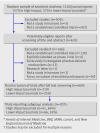The influence of study characteristics on reporting of subgroup analyses in randomised controlled trials: systematic review
- PMID: 21444636
- PMCID: PMC6173170
- DOI: 10.1136/bmj.d1569
The influence of study characteristics on reporting of subgroup analyses in randomised controlled trials: systematic review
Abstract
Objective: To investigate the impact of industry funding on reporting of subgroup analyses in randomised controlled trials.
Design: Systematic review.
Data sources: Medline.
Study selection: Randomised controlled trials published in 118 core clinical journals (defined by the National Library of Medicine) in 2007. 1140 study reports in a 1:1 ratio by high (five general medicine journals with largest number of total citations in 2007) versus lower impact journals, were randomly sampled. Two reviewers, independently and in duplicate, used standardised, piloted forms to screen study reports for eligibility and to extract data. They also used explicit criteria to determine whether a randomised controlled trial reported subgroup analyses. Logistic regression was used to examine the association of prespecified study characteristics with reporting versus not reporting of subgroup analyses.
Results: 469 randomised controlled trials were included, of which 207 (44%) reported subgroup analyses. High impact journals (adjusted odds ratio 2.64, 95% confidence interval 1.62 to 4.33), non-surgical (versus surgical) trials (2.10, 1.26 to 3.50), and larger sample size (3.38, 1.64 to 6.99) were associated with more frequent reporting of subgroup analyses. The strength of association between trial funding and reporting of subgroups differed in trials with and without statistically significant primary outcomes (interaction P=0.02). In trials without statistically significant results for the primary outcome, industry funded trials were more likely to report subgroup analyses (2.29, 1.30 to 4.72) than non-industry funded trials. This was not true for trials with a statistically significant primary outcome (0.79, 0.46 to 1.36). Industry funded trials were associated with less frequent prespecification of subgroup hypotheses (31.3% v 38.0%, adjusted odds ratio 0.49, 0.26 to 0.94), and less use of the interaction test for analyses of subgroup effects (41.4% v 49.1%, 0.52, 0.28 to 0.97) than non-industry funded trials.
Conclusion: Industry funded randomised controlled trials, in the absence of statistically significant primary outcomes, are more likely to report subgroup analyses than non-industry funded trials. Industry funded trials less frequently prespecify subgroup hypotheses and less frequently test for interaction than non-industry funded trials. Subgroup analyses from industry funded trials with negative results for the primary outcome should be viewed with caution.
Conflict of interest statement
Competing interests: All authors have completed the Unified Competing Interest form at
References
-
- Assmann SF, Pocock SJ, Enos LE, Kasten LE. Subgroup analysis and other (mis)uses of baseline data in clinical trials. Lancet 2000;355:1064-9. - PubMed
-
- Bhandari M, Devereaux PJ, Li P, Mah D, Lim K, Schunemann HJ, et al. Misuse of baseline comparison tests and subgroup analyses in surgical trials. Clin Orthop Relat Res 2006;447:247-51. - PubMed
-
- Hernandez AV, Boersma E, Murray GD, Habbema JD, Steyerberg EW. Subgroup analyses in therapeutic cardiovascular clinical trials: are most of them misleading? Am Heart J 2006;151:257-64. - PubMed
-
- Pocock SJ, Hughes MD, Lee RJ. Statistical problems in the reporting of clinical trials. A survey of three medical journals. N Engl J Med 1987;317:426-32. - PubMed
-
- Wang R, Lagakos SW, Ware JH, Hunter DJ, Drazen JM. Statistics in medicine reporting of subgroup analyses in clinical trials. N Engl J Med 2007;357:2189-94. - PubMed
Publication types
MeSH terms
Grants and funding
LinkOut - more resources
Full Text Sources

